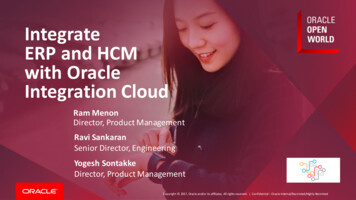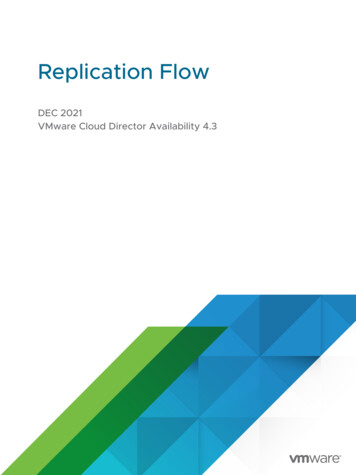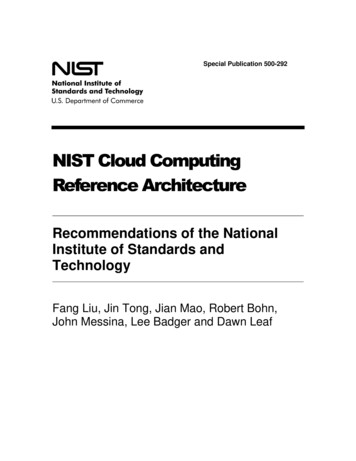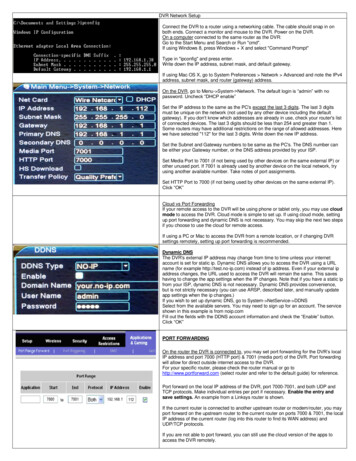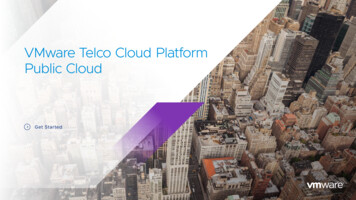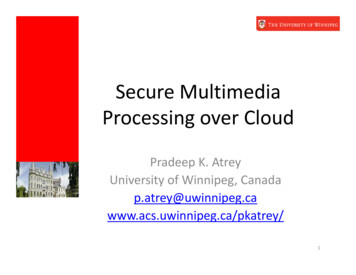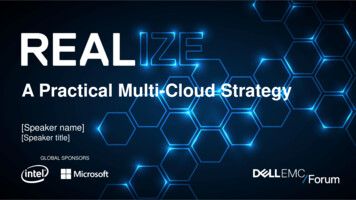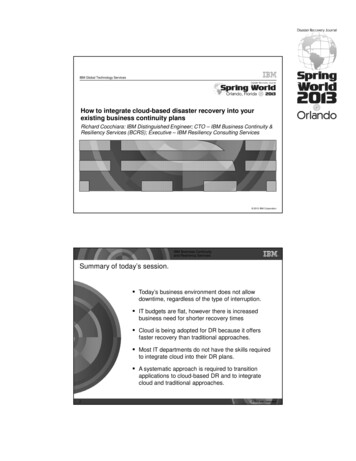
Transcription
IBM Global Technology ServicesHow to integrate cloud-based disaster recovery into yourexisting business continuity plansRichard Cocchiara: IBM Distinguished Engineer; CTO – IBM Business Continuity &Resiliency Services (BCRS); Executive – IBM Resiliency Consulting Services 2013 IBM CorporationIBM Business Continuityand Resiliency ServicesSummary of today’s session. Today’s business environment does not allowdowntime, regardless of the type of interruption. IT budgets are flat, however there is increasedbusiness need for shorter recovery times Cloud is being adopted for DR because it offersfaster recovery than traditional approaches. Most IT departments do not have the skills requiredto integrate cloud into their DR plans. A systematic approach is required to transitionapplications to cloud-based DR and to integratecloud and traditional approaches.2 20132012 IBM Corporation
IBM Business Continuityand Resiliency ServicesIT departments are facing pressures due to increasing volumes ofdata, intensifying regulatory requirements and expectations forcontinuous business operations.The amount of information managed byenterprise data centers is expected to increaseby at least 50 times over the next decade1The average cost per hour of systemdowntime is increasing as more businessoperations become automated 2 182K50x2010 110K202040 Zettabytes*2010*Zettabytes equals 1 trillion gigabytes1. Source: IDC Digital Universe Study, June 20112012Average cost of one hour of downtime2. Source: Aberdeen Group: “Datacenter Downtime:How Much Does it Really Cost?,” March 2012 20132012 IBM Corporation3IBM Business Continuityand Resiliency ServicesAnd external threats are increasing globally, with economic lossesfrom all types of disasters escalating rapidly.2012 Natural CatastrophesSource: Münchener Rückversicherungs-Gesellschaft, Geo Risks Research, NatCatSERVICE, January 20134 20132012 IBM Corporation
IBM Business Continuityand Resiliency ServicesProtecting business-critical data, applications and operations againstdowntime and disruptions is crucial for every organization.Would your company survive a major outage?Why you are increasingly vulnerable:Why a robust resilience solution: Increasingly high volumes of data,applications Support continuous data and operationalavailability Geographically-dispersed facilities Improve your competitive position andreputation Evolving industry and governmentregulations Improve operational efficiency Expectations and demands fromstakeholders Reduce risk 20132012 IBM Corporation5IBM Business Continuityand Resiliency ServicesIT risks like system outages and data loss can put an organization’sreputation – its most valuable corporate asset – at risk.IT risks* have a major impact on a company’sreputationCompanies have rising IT risk concerns related toemerging technology trendsCompanies are integrating IT risk andreputational risk management, with strongestfocus on threats to data and systemsDownload the full study reportibm.com/services/riskstudy“IT and reputational risk management andmitigation are key success factors of ourbusiness and must be given dueemphasis.”C-level executive,Malaysian agriculture and agribusiness company*IT Risk is “The business risk associated with the use, ownership, operation, involvement, influence and adoptionof IT within an enterprise.” Source: ISACA – Information Systems Audit & Control Association, June 20116 20132012 IBM Corporation
IBM Business Continuityand Resiliency ServicesThe study shows a clear mismatch between how well companiesrate their reputation and how well they are protecting it.8017%rate reputationor% asveryexcellentgoodrate their company’s overall ability tomanage IT risk as very strongThere is room for improvementin almost every organizationSource: 2012 Reputational Risk and IT Study, a report by the Economist Intelligence Unit commissioned by IBM7 20132012 IBM CorporationIBM Business Continuityand Resiliency ServicesBusiness resiliency is directly related to the top IT risk factorsto an organization’s reputation.Source: 2012 Reputational Risk and IT Study, a report by the Economist Intelligence Unit commissioned by IBM8 20132012 IBM Corporation
IBM Business Continuityand Resiliency ServicesIT risk management planning and cloud-based managed servicescan help organizations mitigate and respond to these IT risks.Planning, Design & ImplementationCloud-based Managed Services Data Protection Services IT Risk Assessment Services Business Continuity Assessment Services Cloud Resiliency Planning, Design &Implementation Services Disaster Recovery Services9 20132012 IBM CorporationIBM Business Continuityand Resiliency ServicesPressures to do ‘more with less’ drive IT decisions to meetfluctuating business needs with innovative technology solutionsHow Important Was Improved Disaster Recovery And Business ContinuityIn Your Firm’s Decision To Adopt The Following?Source: Cloud-Based Disaster Recovery Barriers And Drivers In The Enterprise, A Custom Technology Adoption Profile Commissioned By IBM (Mar 2012)10 20132012 IBM Corporation
IBM Business Continuityand Resiliency ServicesWith flat IT budgets, increasing pressures to minimize downtime arecausing a need to solve gaps with new technologies.Cloud solutions caneconomically fill thisgapSource: Transitioning business continuity to the cloud 20132012 IBM Corporation11IBM Business Continuityand Resiliency ServicesCloud-based business resilience is designed to help youeconomically and securely meet changing business needs forrecovery, continuity and availability.DifferentiatorsIncreased securityand privacyFlexibilityAvailabilityAgilityChoice of12Proof points Helps identify physical assets as a delivery model for added securityand privacy Business model not focused on data mining or advertising World-class delivery from IBM helping to improve resiliency and security Delivery models tailored to your business Scalability Pay-as-you-go pricing model Workloads that can evolve with the needs of the business Integration with traditional environments and other cloud environments Portability—your data is your data; your workloads are your workloads IBM enterprise-class data center experience IBM data center networking and configuration to help provide connectivity Rapid provisioning of new services Service management automation to help enable more effective self-service Delivery models Operating systems Software environment Enabled by open standards 20132012 IBM Corporation
IBM Business Continuityand Resiliency ServicesCertain challenges are slowing the adoption of cloud-basedresilience by a broader community. IT skills gap: the transition to cloud-based DR requires knowledge andapplication of many different technologies Virtualization Cloud Networking (this is a critical skill in order to properly define bandwidth requirements) Application-specific SLA’s must be defined in order to identify which applications should be moved to cloud-based DR (aka application tiering)Changes to management and legacy recovery processes must be documentedIT, business, and recovery teams must be educated on new processesThe type of cloud deployment (public, private, hybrid) must be definedConcerns about security, compliance, and control issues in the cloud must beaddressedTo learn more, visit the IBM booth to see the results of a recent study conducted by Forrester Research:Cloud-Based Disaster Recovery Barriers And Drivers 20132012 IBM Corporation13IBM Business Continuityand Resiliency ServicesSo you’re ready to use cloud for DR. Are you ready to Provide disaster recovery services for production data that’s in the Cloud Identify the resilience tiers with the greatest affinity for cloud resilience Adapt your business continuity management program to govern cloud and noncloud environments Adjust your business continuity procedures for cloud technology recovery Update or create documented IT disaster recovery plans Integrate your existing plans with the new cloud environment Define you network requirements Plan for no connectivityIt is common to see a false sense of securityamong cloud consumers regarding disasterrecovery planning. Just because businesses areoutsourcing the infrastructure (IaaS),applications (SaaS), or platforms (PaaS) to thecloud does not absolve them of the need forserious disaster planning.Reference: Practical Guide to Cloud Service Level Agreements,2012 Cloud Standards Customer Council14 20132012 IBM Corporation
IBM Business Continuityand Resiliency ServicesA systematic approach to adopting cloud-based resilience reducestransition and adoption time and helps you realize benefits faster. 20132012 IBM Corporation15IBM Business Continuityand Resiliency ServicesTransition to cloud-based disaster recovery starts with datadiscovery and requirements definition. Understand the business direction, andidentify and document the resiliencerequirements. Analyze workloads to determine whichapplications and data have the greatestaffinity to cloud recovery. Determine the most appropriate cloudresiliency delivery model. Step 1: StrategyCollect key business resiliencerequirements data on application and datadependencies. Profile existing applications,governing policies, strategies and plans.16 Understand the potential network latency,and define the cloud architecture that willsupport the resiliency requirements. Ascertain legacy resiliency processes thatmay need to change, including plans,policies and procedures such as trainingand communication. 20132012 IBM Corporation
IBM Business Continuityand Resiliency ServicesThe next step is to build a transformation strategy and develop adesign. Design and construct the transition plan,being mindful to manage the differentapplication-specific SLA's. Help manage quality, security andcompliance. Step 2: DesignIdentify candidates with “cloud resilienceaffinity”. Perform financial analysis,proposed resilience tiers placement,architectural diagrams, and executabletransition plan Integrate resilience cloud solution andlegacy recovery into one cohesive picturedetermined by which of the traditionalprocesses in the organization needs to bepreserved. Update policies and procedures, andidentify and document changes tomanagement and legacy recoveryprocesses. 20132012 IBM Corporation17IBM Business Continuityand Resiliency ServicesThe third step is to understand migration, standardization andregistration issues. Run a pilot program in which the initialinstallation or instance is convened at atest center and subsets are tested. Educate all personnel so that they are wellversed in the new environment, includinghow to use the cloud-based services, whatchanges have been made to recoveryprocedures and the use of the recoveryand testing portal. Hands-on supportedtransition provides education throughexample rather than by trial and error. Deploy the new solution. The movebegins, validating each new service untilthe enterprise is confident that it canmanage it.18 Step 3: TransitionProvision target resilience environment.Using methods and tools, we automate,virtual or physical servers for recovery andconfigure the workload for resiliencetesting. 20132012 IBM Corporation
IBM Business Continuityand Resiliency ServicesThe final step is remediation, testing and workload transition tocloud-based disaster recovery. The solution team supporting thetransformation should help manage theorganization’s environment remotely—eitheras a dedicated or shared resourcedepending upon the client’s requirements. Monitoring key performance indexes (KPIs)allows the organization to optimize systemresponse time or other performanceattributes. The network, servers, storagecapacity and productivity are tweaked toexploit their full potential. Testing is a critical aspect of thetransformation phase. The cloud-basedsolution must be able to be integrated withthe existing resilience testing program. Step 4: TransformationTest the resilience strategy, gain customeracceptance, and perform transfer toongoing management. 20132012 IBM Corporation19IBM Business Continuityand Resiliency ServicesThere are many cloud options to evaluate that can be leveragedeffectively to meet your business resilience needs. Cloud computing has unique attributes that drive value, flexibility, and scalability:––––ever-present, convenient, on-demand network accessibilityshared pool of configurable computing resourcesrapid provisioning and release of computing resourcesminimal management effort or service provider interactionThree types of cloud resiliency scenariosManage it Yourself Create virtualized, scalablecloud environment tobackup and recover yourtraditional data centerservices across severalservice tiers.Hybrid CloudResilience as a Service Blend private and publiccloud services to meetyour business demandsfor agility as well as riskappetite for sensitiveapplications and data. Subscribe to cloudenvironment that you buy ona “pay-per-use” basis withvarying rates based uponresilience requirements forappropriate data services.Source: Based on National Institute for Science and Technology (NIST) definition of “cloud computing”20 20132012 IBM Corporation
IBM Business Continuityand Resiliency ServicesThe result is a cloud based resilience solution customized to yourunique needs for recovery, continuity and availability. Resilience Tiers including technical requirements for:– Security– Data latency tolerance– Network bandwidth optimization– Testing requirements Architectural drawings and work products that describe the solution Recommended actions to integrate your program with legacy recoverysolutions and changes required to policies, plans and procedures Transition Plan describing the implementation steps and changes needed tosupport resilient cloud Recovery Test Plan describing the test goals and use cases to validate theresilience cloud File Plan (optional) that describes data and hardware that can be reprovisioned or retired Transformation services to help you transition to your customized resiliencecloud 20132012 IBM Corporation21IBM Business Continuityand Resiliency ServicesObservations and recommendations. Cloud is here to stay and is a viable option for disasterrecovery Not all platforms or applications will be in the cloud, so youneed to integrate traditional DR and cloud-based DR A structured approach is needed to understand the companyarchitecture and the best way to integrate Identification of appropriate workloads for cloud is key Don’t forget about compliance Create a workable implementation plan that providesadequate time for adoption Experience matters when choosing a consulting or cloudmanaged services partner – most of the DR fundamentalsstill apply (i.e. testing)22 20132012 IBM Corporation
IBM Business Continuityand Resiliency ServicesHere are three steps you can take to start to improve yourrecovery times.Learn about cloudbased disaster recovery.Watch the videoUnderstand how cloud-baseddisaster recovery can offersignificant benefits over traditionaldisaster-recovery methods.Consider an IBM SmartCloudResilience Consulting engagementto begin to transition to the cloud.Download the following:Download the paperThe case for cloud-based disaster recoveryQ&A with SmartCloud VSR expertsSmartCloud VSR white paperTransitioning business continuityto the cloud 20132012 IBM Corporation23IBM Business Continuityand Resiliency ServicesHot off the press! Findings from the 2013 Reputational Risk Study. Increasingly, the Chief Digital Officer will ownreputational risk X As cybercrime escalates, so will reputationalrisk Social media is the best tool you have tominimize reputational damage Reputational risk will become a primaryjustification for IT investment Your partners’ compliance with your securityand continuity standards will be mandated24 20132012 IBM Corporation
IBM Business Continuityand Resiliency ServicesVisit the IBM booth and complete 7 simple questions to getyour Reputational Risk score and get an iPad case.25 20132012 IBM CorporationIBM Business Continuityand Resiliency ServicesThankyouRichard CocchiaraIBM Distinguished rvices/continuity26 20132012 IBM Corporation
IBM Business Continuityand Resiliency ServicesCopyright information Copyright IBM Corporation 2013IBM Global ServicesRoute 100Somers, NY 10589 U.S.A.Produced in the United States of AmericaFebruary, 2013All Rights ReservedIBM, the IBM logo, and ibm.com are trademarks or registered trademarks of International Business Machines Corporation inthe United States, other countries, or both. If these and other IBM trademarked terms are marked on their first occurrence inthis information with a trademark symbol ( or ), these symbols indicate U.S. registered or common law trademarksowned by IBM at the time this information was published. Such trademarks may also be registered or common lawtrademarks in other countries. A current list of IBM trademarks is available on the Web at “Copyright and trademarkinformation”.Intel, Intel logo, Intel Inside, Intel Inside logo, Intel Centrino, Intel Centrino logo, Celeron, Intel Xeon, Intel SpeedStep,Itanium, and Pentium are trademarks or registered trademarks of Intel Corporation or its subsidiaries in the United Statesand other countries.Microsoft, Windows, Windows NT, and the Windows logo are trademarks of Microsoft Corporation in the United States,other countries, or both.Other company, product and service names may be trademarks or service marks of others.Use of the information herein is at the recipient's own risk. Information herein may be changed or updated without notice.IBM may also make improvements and/or changes in the products and/or the programs described herein at any time withoutnotice.References in this publication to IBM products or services do not imply that IBM intends to make them available in allcountries in which IBM operates.27 20132012 IBM Corporation
Adjust your business continuity procedures for cloud technology recovery Update or create documented IT disaster recovery plans Integrate your existing plans with the new cloud environment Define you network requirements Plan for no connectivity It is common to see a false sense of security among cloud consumers regarding disaster recovery .
